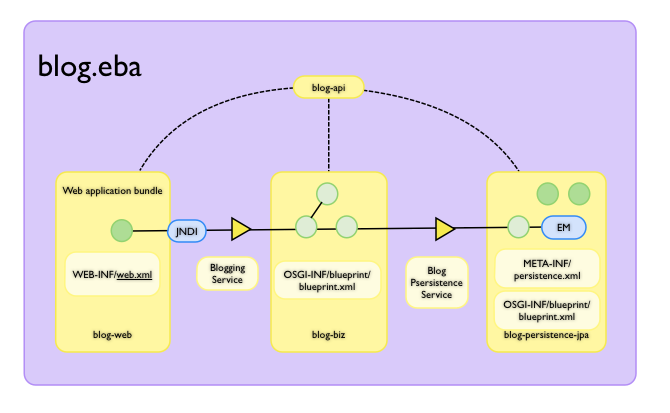The Blog Sample
Running the Blog Sample
- NOTE
-
These instructions are for the 1.0.0 release of Aries. Instructions for older releases can be found here . In the 0.2-incubating release the sample was changed to use an in-memory database to avoid dependency on an explicit version of Derby. If you would prefer to use a database on disk check the instructions for the 0.1-incubating release. You will also need to modify datasource.xml (under blog-datasource) as indicated in the comments and then rebuild the sample.
Create the OSGi platform for the Blog sample
Download and unzip the source zip for the latest release of Aries Samples and build the blog-assembly module:
cd samples-1.0.0/blog/blog-assembly mvn install
This procedure will pull in the binaries from the latest release and its dependencies.
Running the Blog sample
Build the JPA based Blog sample application (.eba file) from the latest release
cd samples-1.0.0/blog/blog-jpa-eba mvn install
-
Change directory to the blog-assembly target directory:
cd samples-1.0.0/blog-sample/blog-assembly/target
now start Aries in an OSGi framework (we’re using Eclipse Equinox in this case)
java -jar org.eclipse.osgi-3.7.0.v20110613.jar -console
The OSGi console should start up, the 'ss' command should show all of the Blog bundles in state 'ACTIVE'.
To start the blog application (.eba file) you built earlier, create a directory call load and copying it into the load directory.
Point your browser to http://localhost:8080/blog/
If you subsequently delete the .eba from the load directory the application will be uninstalled.
Running the sample using a JPA persistence layer
The first blog sample application is written to use a JPA persistence layer. There is an earlier application implemented to demonstrate the JDBC capability
To run the blog sample which uses the JDBC persistence layer, start the OSGi framework, remove any previous copies of the blog sample from the target/load directory, then build and copy the Blog sample JDBC .eba file into the load directory.
Finally, after typing 'refresh' at the OSGi console, point your browser at http://localhost:8080/blog/ . You should see something that looks precisely the same as the blog sample running with the JPA persistence layer, but this time running using the JDBC layer.
Using the latest, unreleased code
If you prefer to use the very latest code from subversion, checkout and build the Aries trunk by following the Building Aries instructions .
